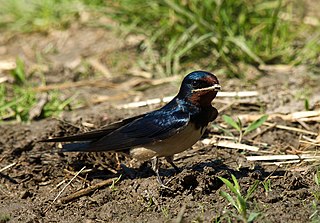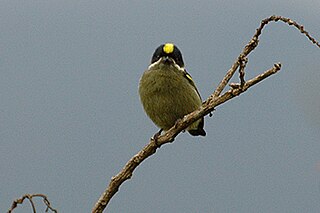
A passerine is any bird of the order Passeriformes which includes more than half of all bird species. Sometimes known as perching birds, passerines generally have an anisodactyl arrangement of their toes, which facilitates perching.

Falcons are birds of prey in the genus Falco, which includes about 40 species. Falcons are widely distributed on all continents of the world except Antarctica, though closely related raptors did occur there in the Eocene.

The thrushes are a passerine bird family, Turdidae, with a worldwide distribution. The family was once much larger before biologists reclassified the former subfamily Saxicolinae, which includes the chats and European robins, as Old World flycatchers. Thrushes are small to medium-sized ground living birds that feed on insects, other invertebrates and fruit. Some unrelated species around the world have been named after thrushes due to their similarity to birds in this family.

The buntings are a group of Old World passerine birds forming the genus Emberiza, the only genus in the family Emberizidae. The family contains 45 species. They are seed-eating birds with stubby, conical bills.

The New Zealand wrens are a family (Acanthisittidae) of tiny passerines endemic to New Zealand. They were represented by seven Holocene species in four or five genera, although only two species in two genera survive today. They are understood to form a distinct lineage within the passerines, but authorities differ on their assignment to the oscines or suboscines. More recent studies suggest that they form a third, most ancient, suborder Acanthisitti and have no living close relatives at all. They are called "wrens" due to similarities in appearance and behaviour to the true wrens (Troglodytidae) but are not members of that family.

The treecreepers are a family, Certhiidae, of small passerine birds, widespread in wooded regions of the Northern Hemisphere and sub-Saharan Africa. The family contains eleven species in two genera, Certhia and Salpornis. Their plumage is dull-coloured, and as their name implies, they climb over the surface of trees in search of food.

The mimids are the New World family of passerine birds, Mimidae, that includes thrashers, mockingbirds, tremblers, and the New World catbirds. As their name suggests, these birds are notable for their vocalization, especially some species' remarkable ability to mimic a wide variety of birds and other sounds heard outdoors. They are commonly referred to as mimic thrushes but are not, in fact, thrushes.

Ploceidae is a family of small passerine birds, many of which are called weavers, weaverbirds, weaver finches, or bishops. These names come from the nests of intricately woven vegetation created by birds in this family. In most recent classifications, the Ploceidae are a clade that excludes some birds that have historically been placed in the family, such as some of the sparrows, but which includes the monotypic subfamily Amblyospizinae. The family is believed to have originated in the mid-Miocene. All birds of the Ploceidae are native to the Old World, most in Africa south of the Sahara, though a few live in tropical areas of Asia. A few species have been introduced outside their native range.

The Cracticinae, bellmagpies and allies, gathers together 12 species of mostly crow-like birds native to Australasia and nearby areas.

The Acrocephalus warblers are small, insectivorous passerine birds belonging to the genus Acrocephalus. Formerly in the paraphyletic Old World warbler assemblage, they are now separated as the namesake of the marsh and tree warbler family Acrocephalidae. They are sometimes called marsh warblers or reed warblers, but this invites confusion with marsh warbler and reed warbler proper, especially in North America, where it is common to use lower case for bird species.

The bird genus Hirundo is a group of passerines in the family Hirundinidae. The genus name is Latin for a swallow. These are the typical swallows, including the widespread barn swallow. Many of this group have blue backs, red on the face and sometimes the rump or nape, and whitish or rufous underparts. With fifteen species this genus is the largest in its family.

The tinkerbirds or tinker barbets are the genus Pogoniulus of the Lybiidae, the African barbet family of near passerines, which was formerly included in the Capitonidae and sometimes in the Ramphastidae. Tinkerbirds are widely distributed in tropical Africa.

Erithacus is a genus of passerine bird that contains a single extant species, the European robin. The Japanese robin and Ryukyu robin were also placed in this genus, but were moved to the genus Larvivora in 2006.

Riparia is a genus of passerine birds in the swallow family Hirundinidae.

Aegithalos is a genus of passerine birds in the family Aegithalidae (bushtits), encompassing majority of the species in the family.

The drongo fantail, formerly known as the pygmy drongo, is a species of passerine bird endemic to the island of New Guinea. It is the only species in the genus Chaetorhynchus. The species was long placed within the drongo family Dicruridae, but it differs from others in that family in having twelve rectrices instead of ten. Molecular analysis also supports moving the species out from the drongo family, instead placing it as a sister species to the silktail of Fiji, and both those species in the fantail family Rhipiduridae.

Artamidae is a family of passerine birds found in Australia, the Indo-Pacific region, and Southern Asia. It includes 24 extant species in six genera and three subfamilies: Peltopsinae, Artaminae and Cracticinae. Artamids used to be monotypic, containing only the woodswallows, but it was expanded to include the family Cracticidae in 1994. Some authors, however, still treat the two as separate families. Some species in this family are known for their beautiful song. Their feeding habits vary from nectar sucking (woodswallows) to predation on small birds.

The laughingthrushes are a family, Leiothrichidae, of Old World passerine birds. The family contains 133 species which are divided into 16 genera. They are diverse in size and coloration. These are birds of tropical areas, with the greatest variety in Southeast Asia and the Indian subcontinent. The entire family used to be included in the Old World babbler family Timaliidae.
Longmornis robustirostrata is an extinct genus and species of bird in the old world oriole family. It was described from Early Miocene material found at the Neville's Garden fossil site at Riversleigh in north-western Queensland, Australia. Its closest living relatives are the figbirds (Sphecotheres), which its beak most closely resembles. It was named in honour of Noel Wayne Longmore, an ornithologist of the Australian Museum, and for its broad, robustly built beak. It was a mid to large-sized passerine, comparable in size to the Australian black-faced cuckooshrike, and was presumed to be a frugivore like modern figbirds.

Zygodactylidae is a family of extinct birds found in Europe and North America from the Eocene epoch to the Middle Miocene. First named in 1971, based on fragmentary remains of two species from Germany, a more complete description of the birds became possible in 2008 when a number of other, better-preserved fossil species were assigned to the family based on a number of shared characteristics.

















